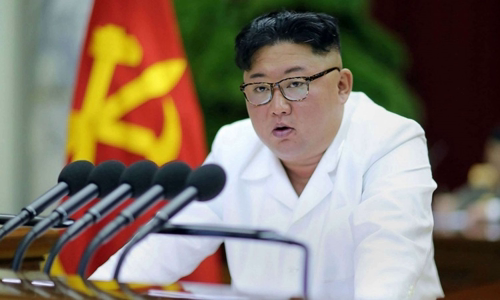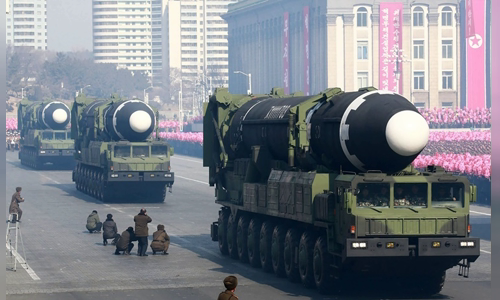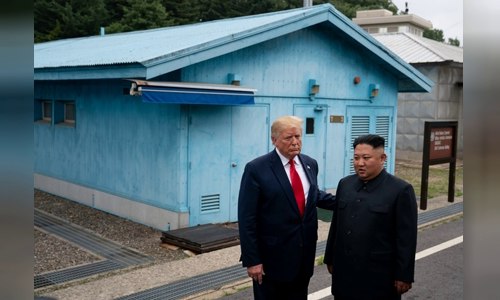When Trump faced a storm of consideration for dismissal and presidential election, Kim Jong-un launched the threat of "new strategic weapons."
North Korean leader Kim Jong-un has long threatened to "find a new way" if the US upholds sanctions on the country. But Pyongyang throughout the year remained open about the road, apparently waiting for the US response to the deadline by the end of 2019.

Kim Jong-un at a meeting of the Central Committee of the Korean Workers' Party on December 29 Photo: KCNA
And when Kim Jong-un announced a new "revolution" on January 1, the strategy showed both the challenging and prudent attitude of Pyongyang when dealing with President Donald Trump.
Kim vowed to develop North Korea's nuclear force, make ambiguous threats about "a new strategic weapon" in the near future, and move towards taking "shocking realistic actions". . He warned North Korea would not suspend testing of nuclear weapons and long-range missiles anymore.
However, Kim also eased those threats by reassuring that efforts to strengthen North Korea's nuclear capacity could be adjusted "depending on American attitudes". Observers assess that this is clearly a tentative approach to create more space for negotiation.
Analysts say Kim is making his calculations based on the political instability in the United States, where Trump is facing the risk of being dismissed while putting his energy into the tough White House race. 2020. North Korean leaders do not want to impatiently sign a deal at risk of being canceled if Trump is not re-elected.
"Kim Jong-un will continue to postpone," said Jean H. Lee, a North Korea expert at Woodrow Wilson International Scholar Center in Washington. "We will see Kim continue to find ways to provoke Washington to gain the upper hand in future negotiations without directly challenging Trump."
In the meantime, Kim can maintain his role as a tough leader, increasing nuclear threats. North Korea can expand its nuclear arsenal, build more warheads and improve its missile capabilities.
What is more difficult to predict is whether Kim will send a wrathful message to Trump by trying nuclear weapons or intercontinental ballistic missiles (ICBMs), if ever.
Such an experiment is sure to provoke "angry fire" from Trump. In 2017, when Kim conducted similar tests, Trump threatened to "completely destroy North Korea," raising concerns about a war.

A parade in Pyongyang in 2018 Photo: AFP
Tensions were eased after North Korea announced a cease-fire of nuclear and missile tests in April 2018. After the Trump-Kim meeting in Singapore in June 2018, the US president said the two "had feelings for each other".
Slowly approaching the United States, Pyongyang also avoids more economic harm. Conducting a new long-range missile test will undoubtedly lead the United Nations to impose additional sanctions on them, while also annoying China and Russia, at a time when North Korea needs them most in order to reduce them. pressures from sanctions.
Sanctions from the United Nations forced Russia, China and many other countries to deport North Korean workers home before the December 22, 2019 deadline, greatly affecting Pyongyang's foreign currency supply. Besides, Chinese tourists now bring a big source of income for North Korea.
In a policy report released last week, Kim acknowledged that North Korea's efforts to reform the economy were facing "serious problems" and "not making significant progress". He complained about "shady activities and stagnation" in key industries, criticizing economic officials for "merely chanting self-help slogans" but not demonstrating leadership. same responsibility to reform the economy.
Kim also implied that he was preparing for a "long-standing" confrontation with the US, calling on the Korean people to accept "the fact that we must live under sanctions". After 18 months of diplomacy with the United States, Kim said he realized the country should stick to "self-reliance" instead of believing Trump's promise to make North Korea's "brilliant transformation" if Pyongyang give up. nukes.
He also called on people "to never exchange security and dignity" that the North Korean nuclear program has brought despite "austerity". With those claims, Kim basically acknowledged that his previous approach to Washington had failed.
In 2012, in his first public address as the leader of the country, Kim promised that the Korean people "will never have to tighten their belts again".
A year later, he announced that North Korea would pursue a policy of parallel development of economy and nuclear weapons.

Trump - Kim met in the Demilitarized Zone in June Photo: NYTimes
By April 2018, Kim confirmed that the North Korean nuclear force was complete, so he would stop testing nuclear and ICBM to focus all his efforts on economic development.
Two months later, Kim and Trump met in Singapore. But talks between the two sides stalled after a summit in Hanoi in February last year, when no denuclearization agreements were signed.
The deadlock in the negotiations led to Kim's deadline for the US to meet by the end of 2019 to show goodwill, otherwise it would receive a "Christmas gift" from Pyongyang. This seems to be an implicit warning that North Korea will return to the old path. But this deadline also shows how North Korea wants to loosen economic constraints.
"The New Year's message Kim broadcast accidentally exposed the hardship of North Korea," said Professor Leif-Eric Easley at Ewha Womans University in Seoul, South Korea. "Kim tried to seek financial benefits from Russia and China but did not want to be seen as dependent. He urged his military engineers to develop more sophisticated weapons but had to take into account risks. "He wanted to increase political pressure on South Korea and the United States but understood that an excessive provocation could lead to more sanctions."
In the New Year 2020 message, Kim did not appear on television as usual. Instead, the North Korean central television channel KCNA re-directed his policy announcement.
The new directive from Kim means, "North Korea will abandon its denuclearization dialogue with the United States, accept a long-standing confrontation and sanctions as a reality, while strengthening its self-reliance, including nuclear and missile capabilities, "said Cheong Seong-chang, senior analyst at Sejong Institute, South Korea.
On the other hand, Kim seems to be intending to give the military a more prominent role in the administration, although it is unclear whether he has tested the ICBM.
North Korean state media recently reported that Kim is promoting the development of new weapons technologies, such as harder-to-intercepted solid-fuel missiles and new submarine-launched ballistic missiles.
"Many voices in the North Korean government support the testing of new weapons systems, be it solid fuel missiles or ICBMs, as well as new warhead designs," said Adam Mount, an expert at the Federation. American scientists, said. "When negotiations stall, these voices will quickly increase influence."



 CarolynSproles
CarolynSproles







